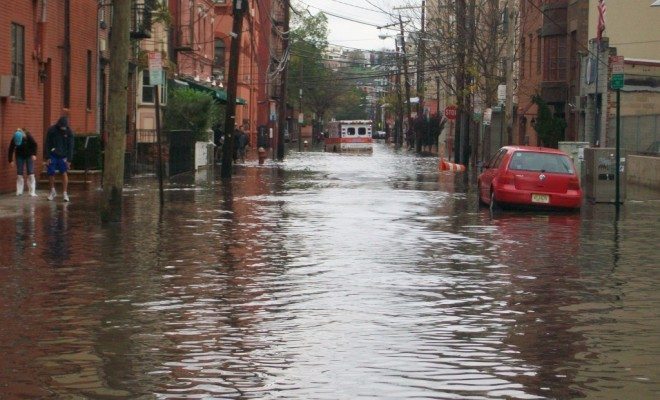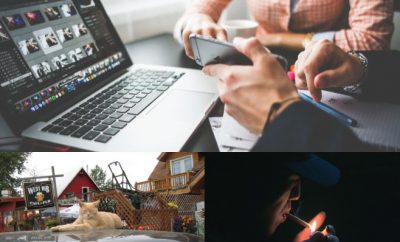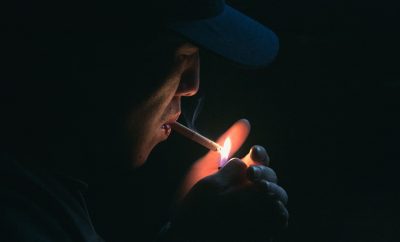
Society and Culture
Post Traumatic Sandy Disorder – One Year Later
Folks, today marks the one-year anniversary of Hurricane Sandy.
Last year, on October 28th, I walked to a nearby pub called Onieals to grab dinner for me and my wife (then fiancée). Onieals has the best burgers in Hoboken, and I figured it would be our last opportunity to eat meat for awhile.
The storm was supposed to roll in that night. As I walked the three blocks to pick up our order, it was dark, cold, and cloudy, the wind biting sharply against my sweater. The streets were eerily empty. Back at home, we had stocked up on cases of bottled water and plenty of non-perishable food. The whole town waited with baited breath for the worst.
Finally made it to the grocery store to stock up. No more bread. Who needs bread anyway? Too many carbs. #Sandy pic.twitter.com/lF8iJPBG
— Casper Andreas (@CasperAndreas1) October 28, 2012
As it turns out, the storm didn’t hit until the next day. From morning until night on the 29th, my wife and I watched the local news, our heat cranked up, making the most of our final electricity-filled hours. We watched as the storm submerged Atlantic City, working its way up the coast. Rain pelted our windows. The lights stayed on.
Until they didn’t. Around 9 p.m., I took a peek out of our bedroom window, hearing screams from outside. The streets were empty. All was well.
Then, ten minutes later, when the screams got louder, I looked again. All of a sudden, there was three feet of water in the street, and rising. Our car was floating. Our apartment building—and all the buildings around us—became an island in a sea of gasoline-tinged floodwaters. The lights went out. My wife and I huddled in bed, trying to block out the screams of thousands of car alarms blaring outside. It sounded like the end of the world.
Morning came, and the water was higher. Firemen paddled through the streets on inflatable boats, looking for people to rescue. I called out to them from our open window, asking if there were any evacuation orders. No, they told me, stay where you are. It took my wife and I days just to get out of our third-floor apartment—the flood waters filled the first floor of our building, along with an array of garbage it had washed in, blocking our exit.
On day three, the waters in our neighborhood had drained. Stir crazy, we went outside to survey our destroyed car. We took a walk through the town, detouring around the areas that still hadn’t drained. Every basement and ground floor apartment in town was destroyed. Every car was totaled. Abandoned ambulances floated in the middle of flooded streets, signaling failed rescue attempts.
FEMA set up camp downtown, and volunteers from around the world gathered to help. Wealthier residents, who paid to live on higher ground, offered their newly recovered electricity to the public, stringing power strips out of their front windows. They served hot food and drinks while strangers—including us—charged their phones at their front doors.
My wife and I had no power for 8 days. We lost our car. Our apartment was so cold, we spent most of our time huddled together, napping under mountains of blankets, trying to ignore the visibility of our breath. When the heat came back on, we both nearly cried for joy.
That was a year ago, and we were pretty lucky. Tons of other Hoboken residents lost everything. Our families in southern New Jersey lost a lot of things too. And those epic photos you’ve seen of the destroyed boardwalks along the Jersey Shore? That’s where we grew up. Things still aren’t quite the same.
Since the storm, I like to joke that we’ve all come down with PTSD—Post Traumatic Sandy Disorder. Nowadays, we all sleep with a flashlight on the nightstand, with an extra tank of gas in the garage, with a zillion spare batteries in the fridge. The sound of car alarms still makes me want to hide under the covers. And the word hurricane strikes a new kind of fear into our hearts.
But the fact is, while we were all deeply affected by Hurricane Sandy, memorializations of tragedies like these tend to gloss over the realities of wealth inequality and marginalization. I’ve stumbled across countless stories detailing the destruction of the storm, and the resilience of communities who are rebuilding and bouncing back. But that ability to bounce back isn’t the same for everyone.
I’ve written before about how women, queers, and people of color are more likely to struggle with poverty. So, let’s take a wild guess as to who was hit hardest by a storm like this, and who would have the most difficulty recovering afterwards?
In Hoboken, it was easy to see. This city is basically a tiny microcosm—it’s an incredibly small town geographically, but it’s filled to the brim with people, spatially divided by race and socioeconomic class.
The projects and low-income housing options are located in the lowest section of town—that means that the poorest people experienced the worst flooding, and went without power for the longest period of time. By contrast, there’s a whole other neighborhood that’s filled with multimillion-dollar condos—unsurprisingly, their elevated position meant they experienced the least flooding, and lost power for all of (maybe) 24 hours.
Not to mention, early childhood education programs and local emergency healthcare—all crucial services for the economically disadvantaged—were completely destroyed in the storm. These facilities were closed unceremoniously, and no alternatives were provided. Many of them have only just reopened, if they’ve managed to do so at all. Add that to the reality that many of the folks affected by these closings could have easily lost their cars, homes, and jobs in the storm, and you’ve got a situation that’s overwhelmingly difficult to get out of.
My wife and I were lucky. We lost plenty, but neither of our jobs were destroyed in the storm, we had good insurance coverage, and a healthy savings account. We had the economic resources and infrastructure to rebuild our lives post-Sandy, and these days, things are pretty much back to normal.
But we’re white, college-educated, working to middle-class women. We have a certain level of privilege that tipped the scales in our favor. Not everyone has that. And as a result, not everyone could bounce back from this storm as well as we did.
So this Halloween season, while you’re reading all of these post-Sandy retrospectives in the news, think critically about who the storm affected and how. Is there something you can do to help those who haven’t been able to bounce back—and who, likely, haven’t been featured in the upbeat, restore the shore narrative?
Because when economic disadvantage is a problem before a tragedy like this happens, it’s not always so easy to pick up the pieces afterwards.
—
Hannah R. Winsten (@HannahRWinsten) is a freelance copywriter, marketing consultant, and blogger living in New York’s sixth borough. She hates tweeting but does it anyway. She aspires to be the next Rachel Maddow.
Images courtesy of [Hannah R. Winsten]











Comments